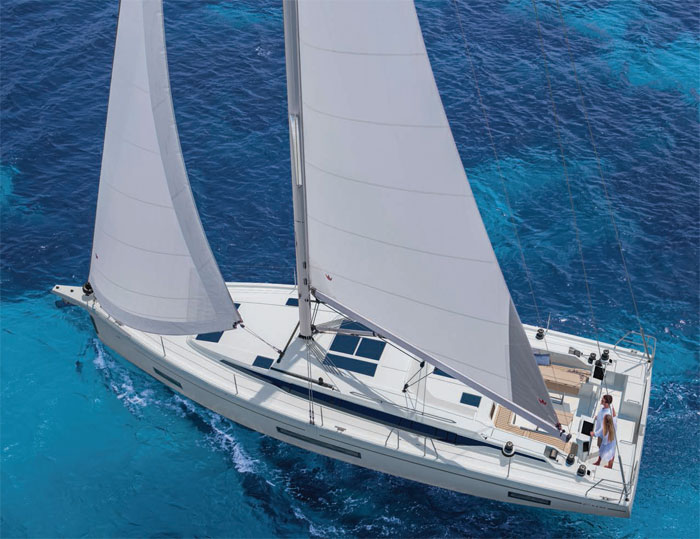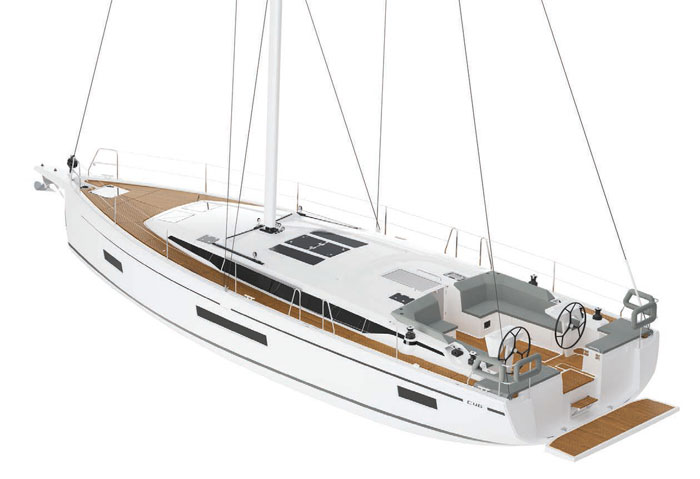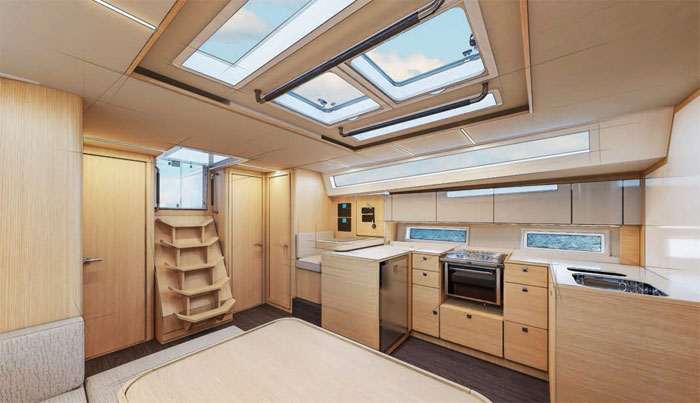

Maurizio Cossutti is a world-renowned designer of some very fast racing yachts. Similarly his latest creation for the growing mid-size cruising yacht market was never going to be anything but an outstanding performer...
If you sail Bavaria yachts on charter holidays you may have noticed that over the last few years their new monohull models have become increasingly rewarding to sail. The credit for that is partly due to Maurizio Cossutti, the naval architect responsible for the CLine boats, but it’s also down to a new way of thinking that has taken root within the company when it comes to creating the concepts for new models.
So how do they do it? If you’ve imagined a complex workflow of intense discussions between senior technicians, sales directors, naval architects, purchasing managers, manufacturing engineers, interior designers, business analysts and two dozen other stakeholders, you’re not entirely wrong. All of that does happen during the development process. But the birth of the concept is deliberately kept quite simple – and more logical from a sailor’s point of view. These days it tends to start with a few key people leaving the office to go sailing together.
The concept for their latest model, the Bavaria C46, took shape last summer off the coast of Croatia. A team of five led by CEO Marc Diening spent a week cruising and living aboard a variety of yachts from the current and previous ranges, discussing key features and debating their pros and cons.
‘The requirements for a sailing yacht of around 15 metres demand much more versatility today,’ Diening says. ‘Boats can no longer be divided into classic categories such as performance cruiser or family cruiser, charter yacht or owner’s yacht. During the development of the Bavaria C46, our focus was solely on identifying the things that offer our customers real added value on board.’

The naval architecture of the new Bavaria C46 is a direct development of Maurizio Cossutti’s widely acclaimed recent designs, the C42 and C38. But many of the key features on deck are derived from successful features on earlier models
Instead of developing parallel ranges of yachts that are optimised specifically and separately for charter companies and for private owners, Bavaria is now developing new models that are equally suitable for various types of use, from daysailing to long-distance cruising, with more emphasis on sailing qualities such as performance, balance and helm response than ever before.
‘Everyone loves to sail fast whether they are racing or cruising,’ says product manager Udo Erbe, who was part of the core team that created the concept for the Bavaria C46 in Croatia. ‘And it’s also about safety, being able to reach a safe harbour before a gale starts. We no longer have a mindset of “let’s develop a family cruiser or a performance cruiser”. When we ask our customers and our dealers they all value boatspeed and they are all delighted with the Bavaria C38 and C42.’
Erbe and Diening are cruising sailors at heart, but Marcus Schlichting, part of the Bavaria Yachts marketing team, is an experienced racer who brings a different, complementary set of sailing values to the core team. ‘Whether you are a racer or a cruising guy you want the handling of the boat to be as easy, as quick and as safe as possible,’ he says. ‘The same deck plan and cockpit layout must work equally well for a family who only sail short distances in good weather and for keen sailors who are going to take the boat out in testing conditions and for example sail from Cuxhaven to Helgoland in a Force 6 with the tide against.’
The new approach resulted in surprises even for the long-serving members of the core development team. ‘When looking for the right solution, detail by detail, we were able to disprove some of the compromises that were assumed to be necessary in many places,’ Diening explains. ‘And with the C46 we have found the balance that our customers expect from a sailing yacht of this size, with many well thoughtout solutions.’ The 15-metre slot in Bavaria’s monohull cruiser range is arguably its most important segment and the new Bavaria C46 will be built in parallel with two successful existing models, the Bavaria C45 and Cruiser 46, which are set to remain in production. In terms of naval architecture the C46 is a direct evolution of Cossutti’s most recent designs, the C42 (which won European Yacht Of The Year) and the C38. Many of its features however, on deck and down below, are developed from ideas and innovations on the Cruiser 46 and C45.
‘We made a long list of use cases before we started the sailing week,’ Erbe says. ‘Then we each evaluated all aspects of the boats, noting what is good, what is bad, how we can optimise it. And we argued a lot. The winch layout in particular required a long, intense discussion to get it right.’
They settled on a two-winch standard layout designed for the default sailplan of a large self-tacking jib and an in-mast furling mainsail. On each side of the cockpit two winches are mounted between the helm and the crew seating area, one for the jib sheet and one for the main. However, the cockpit moulding is reinforced in several other places to allow a range of different use cases. For a larger crew who sail with an overlapping genoa, code zero and gennaker, another pair of winches can be mounted on the coamings, giving three people ample space to trim the sails without getting in each other’s way. For experienced owners who cruise shorthanded with more than the standard sailplan, the two extra winches can be mounted within arm’s reach of the helm.
Below decks, the bulkheads are positioned to allow a wide variety of modular interiors to be built, offering three, four or five cabins with different layout options for each. One of these is a palatial forecabin with separate heads and shower compartments, a technical/utility room or bunk room for professional crew, and convertible double/twin aft cabins. A four-double cabin layout with three heads is likely to be a popular option. But in all cases, the interior is informed by the surprising discovery that both charterers and private owners wanted more of the interior volume devoted to standing space in the cabins – and less to the saloon.

The impression of space in the C46’s bright and airy saloon is enhanced by a combination of big skylights, through-hull windows and a light hardwood finish with a carefully selected sheen. And the traditional chart table has made a comeback…

The traditional nav station has also made a comeback. ‘People increasingly want a home office on board and the chart table is quite often used as an extension to the galley,’ Schlichting says. ‘In Croatia one evening Marc Diening, Udo and I were on an old Cruiser 56 and we realised how good its saloon layout is. You sit a bit higher at the chart table and can have a good conversation with people at the other end of the saloon. It’s also a proper place for passage planning and navigation, and it’s a good place to sit inside while sailing, so we’ve adapted that layout for the Bavaria C46.’
The C46’s tank capacity is also huge, which suits long-distance cruisers and charter customers alike. ‘From the C45 to the C57 you have about 600 litres of water but on the C46 you can have an additional 200 litres,’ Erbe says. It can all be fresh water or you can have a 200-litre grey water tank. That’s a lot for this kind of boat.’
Bavaria Yachts is also bringing in lithium batteries with the C46, which will effectively double the amp-hours available. Solar panels with a peak capacity of 350W will be neatly integrated into the bimini, giving about 20A of charging power. Full electric and hybrid propulsion options are still a little way off, however. ‘Three to five years is a realistic time span,’ Erbe says.
Another notable detail on the new generation of C-Line yachts is that while they are quite wide in the beam with plenty of form stability and lots of interior volume, they are no longer among the beamiest boats in their class. That’s because sailing ability has become a more important consideration in the design process.
To boost boatspeed in light winds and improve performance across the full range of points of sail, the hull volume has been reduced by tens of centimetres here and there – which would have been absolutely unthinkable in previous years. 'The interior spaces are still very big and we have other ways to give a good feeling of space,’ Schlichting says. ‘We put a lot of skylights and hatches in, as well as large throughhull windows. We play with the light and the finish of the wooden surfaces.’
The huge benefit of taking a few centimetres from parts the interior is that you end up with a more engaging boat to sail. ‘You can have a lot of fun upwind as well as downwind,’ Schlichting says. ‘With the self-tacking jib you can easily sail up narrow channels where you wouldn’t with an overlapping genoa. If you have a feel for good sail trim and the right angle upwind, you’ll be half a knot faster than if you don’t. And these boats sail slightly closer to the wind than most cruisers, pointing a few degrees higher and going a bit faster.'
‘With our new way of thinking, the best solution can be a compromise but it does not have to be a compromise,’ he says. ‘The key is always to find the best balance between all the solutions.’
The C46 is now in production and the first boats will be on the water in May or June this year.
Click here for more information on Bavaria Yachts »
We invite you to read on and find out for yourself why Seahorse is the most highly-rated source in the world for anyone who is serious about their racing.
To read on simply SIGN up NOW
Take advantage of our very best subscription offer or order a single copy of this issue of Seahorse.
Online at:
www.seahorse.co.uk/shop and use the code TECH20
Or for iPad simply download the Seahorse App at the iTunes store


